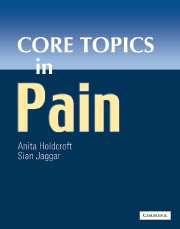Book contents
- Frontmatter
- Contents
- Contributors
- Preface
- Acknowledgements
- Foreword
- General abbreviations
- Basic science abbreviations
- PART 1 BASIC SCIENCE
- PART 2 PAIN ASSESSMENT
- Section 2a Pain measurement
- Section 2b Diagnostic strategies
- PART 3 PAIN IN THE CLINICAL SETTING
- Section 3a Clinical presentations
- Section 3b Pain syndromes
- PART 4 THE ROLE OF EVIDENCE IN PAIN MANAGEMENT
- PART 5 TREATMENT OF PAIN
- Section 5a General Principles
- Section 5b Physical treatments
- 34 Physiotherapy management of pain
- 35 Regional nerve blocks
- 36 Principles of transcutaneous electrical nerve stimulation
- 37 Acupuncture
- 38 Neurosurgery for the relief of chronic pain
- Section 5c Pharmacology
- Section 5d Psychosocial
- PART 6 SUMMARIES
- Glossary
- Index
37 - Acupuncture
from Section 5b - Physical treatments
Published online by Cambridge University Press: 10 December 2009
- Frontmatter
- Contents
- Contributors
- Preface
- Acknowledgements
- Foreword
- General abbreviations
- Basic science abbreviations
- PART 1 BASIC SCIENCE
- PART 2 PAIN ASSESSMENT
- Section 2a Pain measurement
- Section 2b Diagnostic strategies
- PART 3 PAIN IN THE CLINICAL SETTING
- Section 3a Clinical presentations
- Section 3b Pain syndromes
- PART 4 THE ROLE OF EVIDENCE IN PAIN MANAGEMENT
- PART 5 TREATMENT OF PAIN
- Section 5a General Principles
- Section 5b Physical treatments
- 34 Physiotherapy management of pain
- 35 Regional nerve blocks
- 36 Principles of transcutaneous electrical nerve stimulation
- 37 Acupuncture
- 38 Neurosurgery for the relief of chronic pain
- Section 5c Pharmacology
- Section 5d Psychosocial
- PART 6 SUMMARIES
- Glossary
- Index
Summary
The term ‘acupuncture’ derives from the two Latin words: ‘acus’ (needle) and ‘pungere’ (to pierce). It is an ancient Chinese therapeutic technique, which involves the placement of solid needles in precise locations in the body to:
Improve symptoms.
‘Cure’ disease.
Promote health.
Strong sensory stimulation involving needling and scarification techniques have been used to reduce pain throughout history. The exact date of origin of the first use of acupuncture in China is somewhat uncertain, with stone needles, or ‘bian shi’, being used originally in the stone ages. Bone needles have been found that date from the twenty-first to the sixteenth centuries BC in the Xia Dynasty.
Over the last 30 years there has been an increasing interest in acupuncture in the West, with the use of fine disposable needles to help pain and non-pain conditions. This has been partly due to increasing disenchantment with drug therapy and its side effects (including mortality) and partly on account of an increasingly solid neurophysiological and clinical evidence base for its modes of action.
Despite the increasing acceptance of acupuncture among the public and the medical profession, many physicians still have considerable lack of objective information about acupuncture. The erroneous belief that it has no supporting scientific evidence base is still fairly widespread.
- Type
- Chapter
- Information
- Core Topics in Pain , pp. 247 - 254Publisher: Cambridge University PressPrint publication year: 2005



